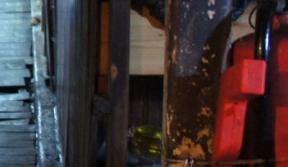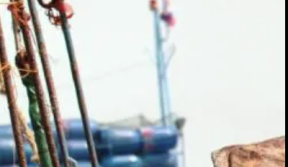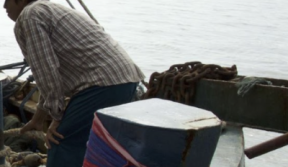
Publication Date:
Public Statement from Human Rights and Environmental Organizations:
MSC's Revised Chain of Custody Certification Fails to Adequately Address Forced Labor and Child Labor in Seafood Supply Chains
As leading labor, human rights, and environmental organizations and members of the Thai Seafood Working Group, we are deeply concerned that the Marine Stewardship Council’s new Chain of Custody Certification will not be effective in identifying, preventing, or protecting seafood workers from labor rights violations. Moreover, the new requirements for assessing risk and preventing child labor and forced labor will not provide buyers and retailers with the assurance that child labor and forced labor are not present in their supply chains.
In March 2019, the Marine Stewardship Council (MSC) released new requirements for its Chain of Custody Certification (CoC) for on-shore seafood operators, which include provisions to address forced and child labor in seafood supply chains, for the first time.[1]
The Thai Seafood Working Group and other concerned stakeholders engaged proactively in the public consultation process to ensure that the labor requirements for the CoC Certification were effective and robust. These stakeholders thoughtfully made recommendations for improving MSC’s labor requirements. MSC incorporated very few of these suggestions.
MSC’s labor requirements are inefficient, ineffective, and problematic in two main areas: (1) the criteria for determining which countries are “high risk” (and therefore requiring that seafood operations undergo labor audits to obtain MSC certification), and (2) the labor audit programs proposed for operations in countries considered to be high risk.
Assessing risk: An operator is exempt from a labor audit if the country they are operating in is deemed “low risk” by meeting at least two of the four indicators set out by MSC.[2] It is extremely problematic that operators seeking MSC certification are not all assessed on an individual basis but at a country level: if a country is considered low risk, then all seafood operators in that country are exempt from the labor requirements for the certification.
Risk assessment and classification on the basis of these criteria will effectively allow seafood operations that may have serious labor abuses to be certified without any labor due diligence. For example, if the current risk assessment criteria were applied to Taiwan, Hong Kong, South Korea, and the US, all would meet at least two of the criteria for low risk. This is alarming, given the well-documented occurrence of forced labor in the seafood and/or fishing sectors in these countries. Other countries where there is some known indication of risk would also be excluded from the labor audits, such as Japan and Singapore. The indicator based on UN convention ratifications is also inadequate for assessing risk in certain countries. For example, Thailand has ratified seven of the conventions (well above the required five), despite known forced labor in its seafood industry.
Labor audit programs: If countries are classified as high risk by the above risk assessment criteria, operators must undergo one of three third-party labor audit programs. The Thai Seafood Working Group has expressed our concern about the use of SA8000, Amfori, and SEDEX as the accepted programs. They have proven to be ineffective in other supply chain industries, such as apparel, palm oil, and cocoa, in some cases with tragic results. One such example is the case of Ali Enterprises, an SA8000-certified Pakistani apparel factory, in which over 250 workers died in a fire on September 11, 2012. The SA8000 auditors had failed to detect and raise the issue of fire hazards and lack of emergency exits. Across multiple industries, there are many examples of the failure of auditors to detect or report violations and of buyers to remediate those violations that are reported. We hope that the seafood industry can learn from these experiences to prevent harm to workers and improve working conditions.
As has been shared with MSC, the principal reasons that third-party labor audit systems are ineffective include: (1) lack of transparency (findings are not disclosed to workers or the public); (2) lack of auditor expertise in labor and industrial relations; (3) weak audit methodologies; (4) lack of worker engagement/inclusion; (4) absence of credible complaints mechanisms; (5) conflict of interest (auditors paid for by the company acquiring certification); and importantly, (6) absence of enforceable mechanisms for remediation.
Forced labor cannot be easily identified or seen as an isolated problem; it is an accumulation of labor rights abuse. Rights violations – such as lack of a contract, withholding of wages, or retention of identity documents – can all be elements of forced labor. Most workers do not end up in situations of forced labor overnight, but are gradually coerced through a range of widespread practices. For these reasons, the snapshot of working conditions provided by an audit is insufficient. All of these issues jeopardize the credibility of the MSC certification and raise serious cause for concern.
Given the weakness of the labor requirements for MSC’s CoC Certification, and given that the requirements will not be revisited for another three years, members of the Thai Seafood Working Group would like to reiterate three recommendations for MSC and other environmental certification bodies considering incorporating labor provisions:
- All seafood operations, regardless of which country they are in, should be required to conduct proper due diligence on labor requirements for MSC certification. This change would reflect the challenges in ranking countries into low and high risk; the invisibility and vulnerability of seafood and fishing workers in many countries; and the importance of ensuring that child and forced labor are detected, prevented, and addressed throughout the supply chain.
- Develop a complaints mechanism that provides workers and labor rights stakeholders with a channel to raise complaints or grievances about labor issues. Such a mechanism would serve to surface labor violations that are not captured in the MSC program – either because they may be occurring in operations in countries that are exempt from the labor requirements, or they are not being detected through the labor audits. This would serve as an important step in addressing the enormous challenges for monitoring labor rights in the seafood supply chain.
- Undertake genuine consultation with labor organizations to develop future iterations of this and other certifications. Engaging and consulting trade unions in the process of developing labor rights criteria should be a key part of stakeholder engagement from the beginning. As MSC considers changes and improvements to the social criteria in their certifications in the future, there should be thorough and genuine consultation with – and a greater incorporation of recommendations from –labor experts, unions, and worker-led organizations.
While we understand that this was MSC’s first step in an effort to address labor abuse in seafood supply chains, we are deeply disappointed by the standard put forward. Indeed, a low-bar approach such as this one is a missed opportunity and a poor model for other sustainability programs seeking to address the rights and well-being of seafood workers.
Sincerely,
Conservation International
FishWise
Freedom Fund
Freedom United
Greenpeace
Green America
International Labor Rights Forum
Humanity United
Human Rights Now
Human Rights Watch
Stop the Traffik Australian Coalition
Sustainability Incubator
Verité
[1] The new labor requirements were released as part of MSC’s revised Chain of Custody Standard, which is a traceability certification for on-shore seafood operators. It guarantees that products sold with the MSC label can be traced throughout the supply chain to a certified source and, as of March 2019, that the products were not made using forced or child labor. Once certified, the entity is able to sell seafood with the MSC-certified label; see https://www.msc.org/for-business/supply-chain/chain-of-custody-certification-guide.
[2] These are the Country Risk Assessment Process for SA8000; the ITUC Global Rights Index; ratification of at least five of select UN conventions; and the U.S. Department of Labor List of Goods Produced by Child Labor or Forced Labor.


